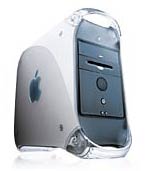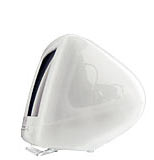


Real World Testing Of
The Fastest, Newest Macintoshes
including Dual G4's and Power Cube.



Real World Testing Of
The Fastest, Newest Macintoshes
including Dual G4's and Power Cube.
Photoshop, iMovie, SoundJam, and Cinema 4D are used to compare the performance of the Dual 500MHz PowerPC G4, Dual 450MHz PowerPC G4, 500MHz PowerPC G4, 450MHz Power Mac G4 Cube, 400MHz PowerPC G4, and the 500MHz iMac (G3) DV Special Edition.

The four functions are Rotate, Gaussian Blur, Render LightingEffects (Flashlight), and Motion Blur. Adobe has posted a new version of AltiVec plugins that includes a MultiProcessor plugin. I tested the "dualies" with and without the MP plugin to show its effect on Photoshop performance. The dual cpu advantage varies from filter to filter (20 to 40%) but the average for these four functions was 26%.
Cinema 4D is my NEWEST "real world" TEST but it produces a strange result. Cinema seems to "know" about dual CPU's but is totally "ignorant" of the AltiVec code of G4's. If you are big on 3D rendering, you'll see an 88% gain if you have dualies.
Too bad iMovie 2.01 isn't dual CPU "aware." At least it is G4 "aware." Maybe Apple will make Final Cut Pro "dualie" aware. It's going to need it.
SoundJam MP Plus is G4 "aware" and dual CPU "aware"... kinda. There was only a 21% advantage with dualies.
Many applications like Bryce, Office 98, and FileMaker don't take advantage of dual CPU's or the G4. If those are your main focus, then invest in the fastest single CPU you can afford. MacSelect is selling upgrades for the G4 Sawtooth. If you have a 350 or 400MHz Sawtooth, you can get a 500MHz daughtercard for $599 exchange. In fact, the single G4/500 used in this test is based on just such an upgrade.
Conclusion
I have mixed feelings about the dual processor G4's. The concept is exciting, but here's the reality: DUAL G4's do NOT make your Macintosh go twice as fast as a single G4. Only certain applications take advantage of dual cpu's. Even then, the advantage can be as little as 20%. Hopefully we'll see that advantage grow when OS X is released and more applications use the Dual G4's the way Cinema 4D uses them.The Cube is cute but for raw power and easy "hot rodding," I'll take the graphite towers.
Other Comments
The G4/450 Cube's PHOTOSHOP performance was curious. It was no faster than the G4/400 Minitower! Huh? If I was choosing between the two just based on Photoshop, I'd go with the G4/400. After all, it's much more expandable.
When you add memory to your G4 or new iMac, be sure it's rated speed is "222." When I first tested the Cube, it had two sticks of "222" and one stick of "333." The "333" is not only slower but the machine runs at that memory speed rating no matter what's in the other slots. Using NewerTech's GaugePRO, it showed the Cube's memory transfer speed dropped from 243 to 217 MB/sec with the "333" module installed.
Does that affect performance? You bet. The Photoshop four part test took a total of 60 seconds with the "333" stick installed. It only took 50 seconds when I replaced the slow chip with a "222." That means it was 20% slower with the slower memory!!! Eeek! (If you are not sure what kind you have, go to Apple System Profiler and look at the memory. If you have mixed speed ratings, it will show the rating of each stick including an asterisk (*) next to the slowest ones.)
If you order your Macintosh at the Apple Store, you'll pay dearly for the bigger drives. And with the exception of the 40GB IBM (35MB/sec) drive that ships with the preconfigured Dual G4/500, the drives Apple is shipping are not that fast. The smaller, slower drives (25MB/sec) include a 20GB Maxtor and 30GB Quantum FireBall LM. A better choice is to do a "build to order" with the smallest drive configuration and then replace it the faster, bigger, less expensive IBM 75GXP drive from your favorite online reseller.
If you are interested in seeing a similar review, MacWorld's site has real world test results using the Dual G4/500 and G4/450.
Test Configurations & Procedures
TEST Apple Macintosh MACHINES: Dual 500MHz PowerPC G4, 500MHz PowerPC G4, Dual 450MHz PowerPC G4, 450MHz Power Mac G4 Cube, 400MHz PowerPC G4, and the 500MHz (G3) iMac DV Special Edition. All systems had 256MB of PC-100 "222" memory. On all machines, virtual memory was off, disk cache was set to minimum (128K), clock display was off, and AppleTalk was off.
Adobe Photoshop 5.5 was given 200MB of application size. The test file was a 27 MB Photoshop photo. The FOUR Photoshop effects were timed using Photoshop's built-in timer. The effects included:
1. ROTATE Clock Wise at 30 degrees.
2. GAUSSIAN BLUR at 30 pixels
3. RENDER LIGHTINGEFFECTS - flashlight, default settings
4. MOTION BLUR (30 pixels at 30 degrees)
A DEMO version is available from Adobe if you want to test your own machine.Maxon Cinema 4D 6.1 is a NEW REAL WORLD TEST I've just added. It's a 3D modeling application. I'll probably use it from now on in place of, or in addition to, Bryce 4.0 since it is "dual CPU aware" and Bryce is not. Cinema comes with various example documents. I chose the "Shadows.c4d" file. I invoked RENDER (Shift + R). It keeps track of the rendering time to the nearest whole second. (A DEMO version is available on their website.)
I used the newest 2.01 version of Apple's iMovie. I ran the "render titles" function as a test since it's so CPU intensive. I typed in a two line title ("My Great Movie by rob art mog") using default settings. Then drag/dropped it in the "story line." I used a stopwatch to time how long it took to render the 188 frames. (If you don't have iMovie 2.0, version 1.02 is available for FREE from Apple's web site. Only catch is that if you duplicate my test using version 1.02, it only renders 122 frames. However, when you do the math, they both render the same number of frames per second.)
Casady & Greene's SoundJam MP Plus 2.5.1 was used to convert a 2.5 minute music selection into MP3 using default settings. With a stop watch, I timed it to the nearest tenth of a second. A DEMO version is available from their website.
Corel Bryce 4.0 3D rendering was used to test a combination of CPU and FPU speed. It's interesting since it's typical of applications that do NOT take advantage of the G4 or dual processors. I use a document I call "Rock Island," a crude creation of my own.
BIG MAHALO TO...
CompUSA Honolulu for letting me test their floor demonstrators (Dual 500, Dual 450, and iMac DV SE). I especially appreciate the cooperation of the Kimo Sutton and Mark Wilson, the Mac "Store Within A Store" sales guys.
MacSelect for letting me use the G4/500 daughtercard upgrade for the Sawtooth.
The Mac Mouse Club dudes (Big Mike and Rolf) for letting me play with their G4 Cube.
SmartDisk/VST for the use of one of their 6GB portable FireWire drives which holds all my latest test applications, test documents, and drivers as I move from test machine to test machine.
© 2000 Rob Art Morgan, editor of
BARE FEATS
Gotta Question? Comment? Want to advertise?
Email rob-art@barefeats.com